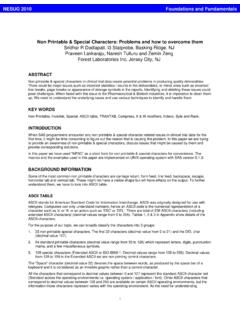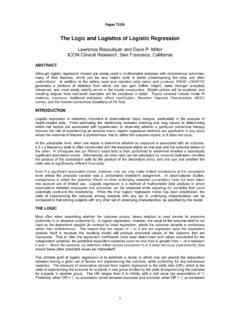Transcription of DIY: Create your own SDTM mapping framework - Lex Jansen
1 PhUSE 2016. Paper CD03. DIY: Create your own sdtm mapping framework Bas van Bakel, OCS Consulting, s-Hertogenbosch, the Netherlands ABSTRACT. This paper describes a mapping framework that has been implemented at a large pharmaceutical company in which internally maintained tools are generated that describe and execute source-to-target mappings in a structured way. The concept of the mapping framework is easy to understand and, because of its modular structure, the framework can be implemented with minimum effort. INTRODUCTION. During the process of generating sdtm data from CDASH-based operational data or other source datasets many data mappings take place.
2 Companies usually have tools available that help in the process of defining and applying these data mappings in order to ensure the sdtm data is generated and it is clearly described how this is done. Tools can be provided by external parties and even though that may have its advantages it might be advantageous to have a company tool available that is not maintained by an external party, but internally. This paper describes a concept that has been implemented at a large pharmaceutical company in which such an internally maintained tool is generated. Within this concept Microsoft Excel is used to describe, in a very structured way, both the human readable source-to-target specifications, as well as the machine-executable SAS code.
3 The paper will not only show the general idea behind the process, but will also have more technical sections that focus on part of the SAS code that is used within this process. THE SCOPE. The examples that are used in this paper focus on generating sdtm from source data, but the framework can also be applied on other sources and other targets as long as the targets are defined in a structured way and their structure can be obtained by the framework . Within this paper it will be explained how the framework makes use of the target metadata' to obtain the expected (trial specific) structure of the target ( the attributes (type, length, etcetera) of the variables of the sdtm domains).
4 And how it ensures the output is aligned with it. Defining and maintaining the metadata of the targets will not be in scope of this paper. THE BASICS. One of the most important aspects of the framework is that there is a single Microsoft Excel spreadsheet that contains all source-to-target specifications and, directly next to them, the translation of these specifications into code or pseudo-code. An example of this mapping specification document is shown below (some columns and rows are hidden). The white columns contain the source datasets and variables. The yellow columns contain the target datasets and variables and the specifications and (pseudo-)code to convert the sources to the targets.
5 1. PhUSE 2016. Macros are available that translate the (pseudo-)code into SAS code, execute that SAS code in a specific order and output the target dataset with the attributes as available in the target metadata'. Independent of the sdtm domain that is to be generated there will always be three macros that are executed in sequence to facilitate this. % mapping : This macro will first determine (per sdtm output domain) which source datasets are needed. Then each of the source datasets are converted into intermediate mapped' dataset(s) by using some of the (pseudo-) code as specified in the mapping specification document.
6 %apply_poststeps: After the mapped' dataset(s) are generated by the % mapping macro the remaining (pseudo)-code is used to further process and combine the mapped' dataset(s) into one single intermediate dataset. %makefinaldomain: After all generated SAS code is executed and all data is combined into one dataset, the sdtm dataset and Supplemental Qualifier dataset are generated by aligning the datasets and variables with the attributes as specified in the target metadata'. The pictures below are examples of the above mentioned process when generating the sdtm Demographics domain from three source datasets and generating the sdtm Disposition domain from a single source dataset.
7 Please note that, independent of the source dataset(s) that are used, the concept remains the same. 2. PhUSE 2016. THE DETAILS. This section will more thoroughly describe the functions of each of the three macros and how they translate the information from the mapping specification document into executable SAS code and subsequently execute this SAS. code to generate the sdtm domains. THE CODE-GENERATING MACROS. The % mapping macro and the %apply_poststeps macro read the (pseudo-)code specified in the FUNCTION column of the mapping specification document, translate that to SAS code and execute that SAS code in a specific order to generate the intermediate (near-final) dataset that is fed to the %makefinaldomain macro.
8 Depending on the function that is specified in the FUNCTION column the SAS code is executed either when the source data is converted to the mapped' datasets (% mapping ) or when post processing and combining of the mapped' datasets take place (%apply_poststeps). The following functions are available and are described in detail in the following paragraphs: % mapping : WHERE', RENAME', COPY', FUNCTION', RECODE', 'STACK1-STACK[n]', KEEP'. %apply_poststeps: POSTSTEP1-POSTSTEP[n]', FUNCTION1-FUNCTION[n]'. THE mapping MACRO. Each source dataset for which any row is available that is marked as being needed to generate the sdtm domain will be read by the % mapping macro.
9 Each of these source datasets will generate one output mapped' dataset. Only the source variables that are marked as being needed in this process are read from the source datasets. For example, in the mapping specification document below, when the AE domain is to be generated, the and source datasets are read because they are both marked as sources for the sdtm AE domain (as indicated by AE' in the column SDTM_DS). When reading the dataset only the variables AEYN and SUBJID will be kept. When reading the dataset only the variables LLT_CODE, PT_CODE, SOC_CODE, HLGTCODE, HLT_CODE and PRIMARY will be kept.
10 Variables that are not needed in the conversion process are marked with specification and function NOT MAPPED . This process ensures that you cannot use variables that you have not marked in the specifications as being needed in the conversion process. Once the source datasets are read, the functions in the FUNCTION column are translated to SAS code and applied when reading the source datasets. The function WHERE'. When the function WHERE [statement] is specified the exact where clause as specified within the brackets will be applied on the source dataset. If there are multiple WHERE-clauses specified they will both be applied on the source dataset so only records fulfilling both clauses will be kept when reading the source dataset.










